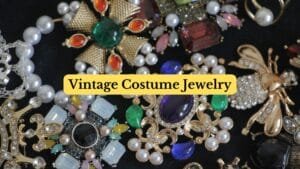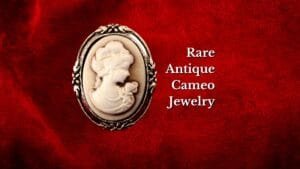I’ve heard many refer to costume jewelry as “fake” jewelry, but most people don’t know that the same one could be worth thousands today if it’s old! That’s right! Vintage costume jewelry is a hot collectible right now, with collectors paying insane prices for it!
So, if you have an old box of ‘fake jewelry’ from your grandmother’s dresser? This guide is just for you! Not only will this guide introduce you to some of the most collectible vintage costume jewelry pieces, but you’ll also learn to spot authentic pieces and what makes them worth the money!
What is Costume Jewelry?
Simply put, it’s decorative jewelry made from non-precious materials. Instead of diamonds and gold, you’ll find glass stones, faux pearls, and base metals.
Costume jewelry really took off in the 1920s when fashion icon Coco Chanel shocked everyone by mixing fake pearls with real ones. She showed the world that jewelry could be about style, not just showing off wealth. But its craze lasted through the World Wars and the Great Depression till the present!
10 Examples of Rare Vintage Costume Jewelry Items
Costume jewelry is sure made of nonprecious materials, but that doesn’t make it any less valuable. The following vintage costume jewelry pieces are examples of its rarity and desirability today.
1. Schreiner New York Crystal Brooch

This breathtaking brooch featuring a large red stone surrounded by what appears to be pearl-like beads is a prime example of Schreiner’s bold design aesthetic. The hefty price tag of almost $8,000 speaks to the rarity of this piece.
The brooch showcases a dramatic red centerpiece surrounded by those luminous pearl-like beads, a classic Schreiner style. It’s bold, it’s luxurious, and it’s meant to be noticed! The scale is impressive too – Schreiner wasn’t about dainty, shrinking violet jewelry.
Schreiner pieces are particularly rare and collectible because many were produced in small quantities. Also, they often used stones of special shapes and unusual colors, which are no longer produced now.
2. Boucher Enamel and Rhinestone Octopus Pin (Phrygian Cap Mark)
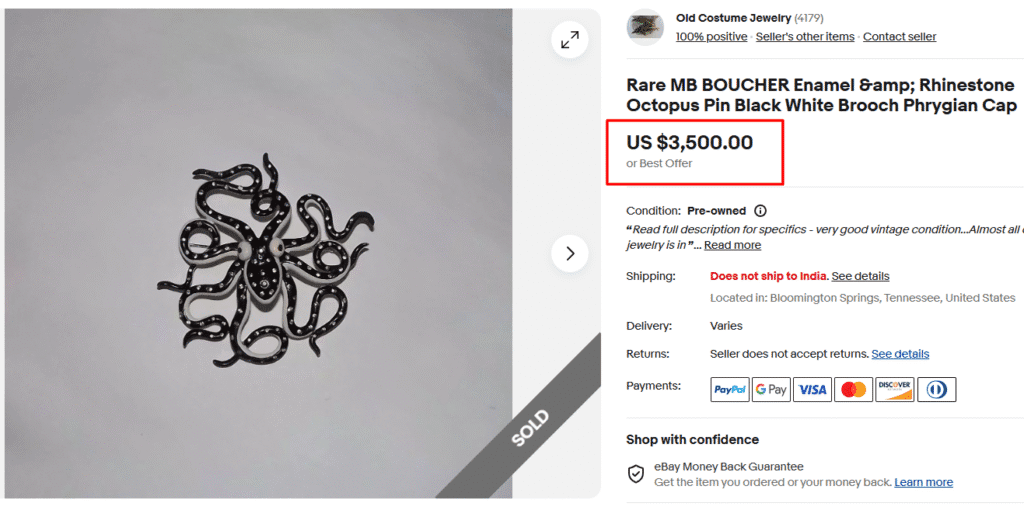
Created by Marcel Boucher, one of the most celebrated costume jewelry designers of the 20th century, this stunning black and white octopus brooch is a true collector’s dream! What makes this octopus pin special is the combination of black enamel work with brilliant rhinestone accents and lifelike tentacles.
Marcel Boucher’s pieces are known for their exceptional quality, intricate details, and three-dimensional designs. The pieces often bear the “Marboux,” “MB,” or later “Boucher” marks with a copyright symbol, making them highly identifiable for collectors.
3. Coro Duette Celluloid Multistone Fur Clips

This fascinating piece shows Eastern-inspired figurals in what appears to be ivory-colored material with turquoise and coral accents. What makes this set rare and collectible is that it’s a “Duette” – Coro’s patented convertible jewelry design.
Coro patented this convertible jewelry concept in 1935, and it was revolutionary! These pieces are essentially two matching clips that you could wear separately, OR connect together using a special frame to create one statement brooch.
The figures in this Duette appear to be made from celluloid and likely represent an empress and emperor or other Asian characters. The detailed carving, especially the tiny facial expressions, is extraordinary!
4. Vintage Eisenberg Sterling Vermeil Brooch

This extraordinary mermaid brooch combines sterling silver construction with vermeil (gold-over-silver) plating, giving off dimensional pink glass “scales” at the mermaid’s tail. The figure features rhinestone accents and a large faceted pink crystal as the centerpiece.
These pieces were created during World War II when Eisenberg switched to sterling silver due to metal restrictions, entering a unique period in American costume jewelry production.
The mermaid brooch, designed by Ruth Kamke, possibly inspired by Verdura’s high-end “Naiad Clip,” shows how costume jewelry makers took inspiration from fine jewelry.
5. Vintage Early Miriam Haskell Glass Pearl Lariat Necklace
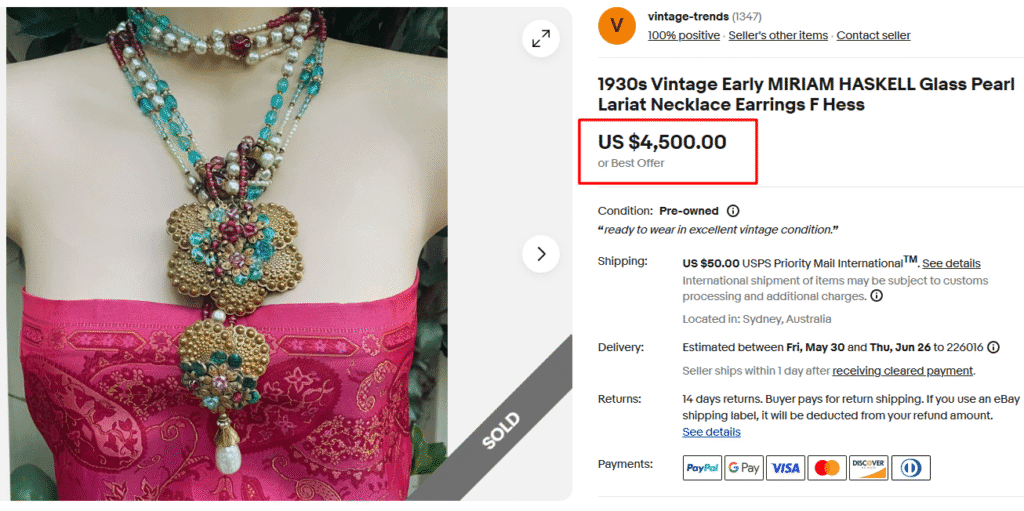
If there’s a piece that represents the pinnacle of hand-crafted costume jewelry, it’s this early Miriam Haskell piece! It shows Haskell’s characteristic attention to detail – every single bead individually hand-wired onto the metal framework, a not-extinct labor-intensive process!
The necklace features a multi-strand lariat with hand-wired baroque glass pearls in cream tones, vibrant turquoise and ruby-colored glass beads, all connected to intricate filigree medallions that showcase Haskell’s signature Russian gold-tone finish.
Dating from the 1930s, this necklace predates Haskell’s permanent signature tags (which began in the 1940s), making construction techniques and design elements sole identifiers.
6. Trifari ‘Alfred Philippe’ Crown Brooch
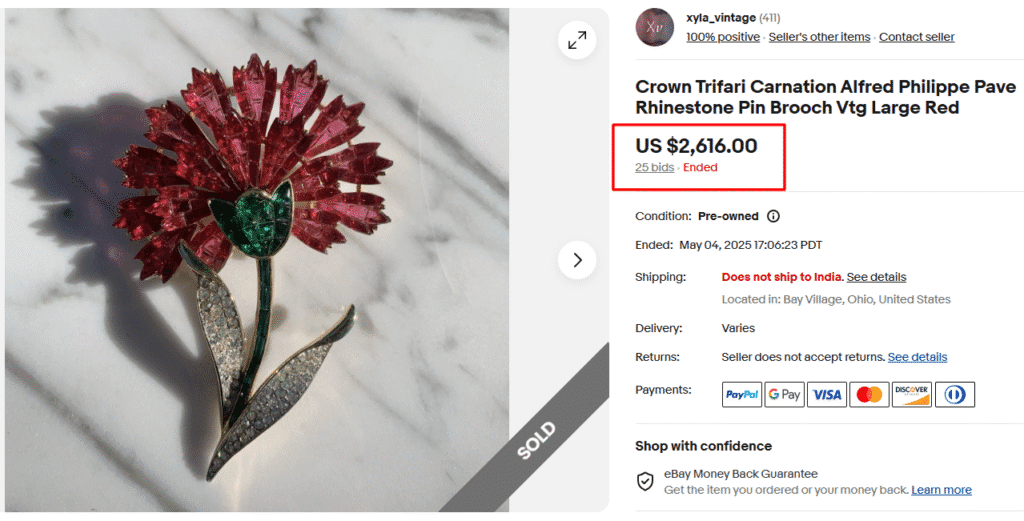
The high value of this red carnation Trifari brooch lies in the fact that it was designed by Alfred Philippe, the legendary designer who defined Trifari’s signature style from 1930 until his retirement in 1968.
What makes it more exceptional is the innovative use of layered, invisibly set red rhinestones that create the dimensional petals of the carnation flower. The green enameled stem and leaves are accented with pavé-set clear rhinestones, adding extra sparkle.
The “Crown” means that the brooch is marked with the crown symbol above the T, dating it to between 1937 and 1955!
7. Chanel Gripoix Glass & Pearl Necklace

Imagine paying $2,000 for fake pearls. Sounds crazy, right? But when they’re Chanel fake pearls, suddenly it makes perfect sense! This gorgeous necklace with its cross-shaped pendant and colorful gripoix stones is a perfect example.
This necklace showcases all the hallmarks of classic Chanel. For instance, the perfect, lustrous faux pearls that look incredibly real and the striking contrast between the pearls and those vivid gripoix glass stones (a special French glass-making technique).
The religious-inspired cross motif (Chanel loved incorporating symbolic elements) and exquisite gold-tone settings (not precious metals) make this necklace super luxurious!
Back in the 1920s, when “proper” ladies only wore real jewels, Coco Chanel boldly declared, “I only like fake jewelry, because it’s provocative.”
8. Trifari Jelly Belly Penguin Crown Brooch

Now here’s a piece that represents vintage costume jewelry royalty. This Crown Trifari penguin brooch features the famous “Jelly Belly” construction – a clear Lucite belly that gives the piece its iconic, almost translucent appearance.
The penguin’s body is outlined with pavé-set rhinestones, and you can see the characteristic black enamel detailing that defines the penguin’s formal “tuxedo” appearance. The Jelly Belly collection was one of Alfred Philippe’s most innovative and successful designs for Trifari, justifying the price tag of $1,200!
Introduced in the 1940s, these pieces also featured figural animals, birds, and insects with rounded middles made from polished Lucite.
9. Hattie Carnegie Aztec Warrior Figural Pin

This striking figural brooch is classic Hattie Carnegie at her most playful and bold. The piece depicts an Aztec warrior or witch doctor figure, adorned with a dramatic headdress of red cabochon stones and emerald green and crystal rhinestone details!
What makes this piece remarkable is its incredible detail – from the figure’s facial features with rhinestone eyes to the elaborate costume with dimensional elements like the staff he’s holding.
The use of vibrant colored stones against the gold-toned metal creates a theatrical, almost costume-like effect that was Hattie Carnegie’s signature style.
10. Juliana D&E Rhinestone Brooch & Earring Set

This stunning emerald-green rhinestone brooch and earring combo is what collectors call “Juliana” jewelry. What makes these pieces identifiable as D&E/Juliana is pretty specific: the incredible “open-back” unfoiled, deep emerald rhinestones.
The way the rhinestones are layered to create dimension and depth adds an elegant, feminine touch to the set. While these pieces are often unsigned, you can try to identify them by construction (puddling on back, figure-eight links).
The “Juliana” name has a funny origin story. The jewelry was actually made by DeLizza & Elster (D&E), but most of their pieces were never signed! Jewelry dealers noticed some vintage hang tags with “Juliana” on them and started using it as a catch-all term for pieces!
How to Identify Authentic Vintage Costume Jewelry?
When it comes to spotting genuine vintage costume jewelry, a few clues are clear indicators. Here’s a breakdown of what to look for:
Materials
Here’s what typically sets costume jewelry apart from fine jewelry:
- It uses brass, copper, or pot metal instead of gold or platinum
- You’ll find glass or acrylic stones rather than real gemstones
- The pearls are simulated, not natural or cultured
- Poured glass (Pâte de Verre), faux pearls, semi-precious stones
- Many pieces feature plastics like Bakelite, Celluloid, or Lucite
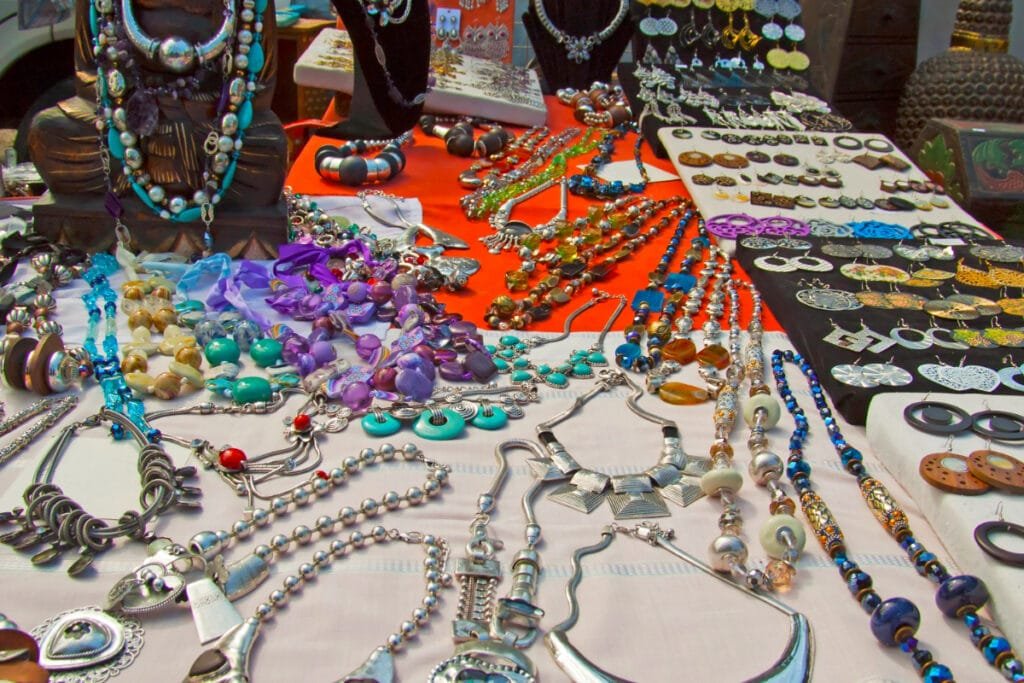
Here are more aging clues based on materials:
- The 20s & 30s Jewelry: These pieces often feature white metals, glass stones, paste (early rhinestones), and sleek art deco geometric designs. Early plastics like Bakelite were huge – it came in fun colors with quirky names like “butterscotch” and “apple juice.”
- The 1940s (WWII Era): During the war, metal restrictions meant jewelry makers got creative. Sterling silver became common in costume jewelry (check for “sterling” marks), and materials like wood, leather, and Lucite filled in when metals weren’t available. Look for patriotic themes and big, bold brooches from this time.
- The Fabulous 50s: Post-war prosperity brought back gold tones and glamour! This is when matching sets with necklace, bracelet, and earrings became all the rage. Movies like “Breakfast at Tiffany’s” promoted costume jewelry even more! The biggest innovation? Swarovski’s Aurora Borealis rhinestones in 1955.
- The Swinging 60s & 70s: The mod era brought plastic, vinyl, bright colors, and global influences. Pieces got bigger and bolder – think chunky chains, large pendants, and hoop earrings. Flower power and bohemian styles used natural materials like wood, bone, and shell.
Look for the Maker’s Mark
The quickest way to identify an authentic and valuable vintage costume piece is to flip it over and look for a signature or mark. Some brands are worth WAY more than others, so this step is crucial!
Types of Marks Found:
- Signatures: Most pieces just have the company name stamped on them. You’ll spot marks like “TRIFARI,” “CORO,” or “HASKELL” right on the piece.
- Initials/Monograms: Some designers kept it simple with just their initials. If you see “MB,” that’s Marcel Boucher’s work. “HC” means you’ve got a Hattie Carnegie piece in your hands.
- Pat. Pending/Patent Numbers: Found “Pat. Pend.” on your jewelry? That means they applied for a patent but hadn’t gotten it yet. Actual patent numbers are even better – you can look them up to nail down exactly when a design was registered.
- Copyright Symbol (©): This little mark is a dead giveaway for newer pieces. They didn’t start using © on jewelry until 1955, so anything with this symbol was made after that.
- Design/Inventory Numbers: The fancy designers like Boucher and Schreiner often added style or inventory numbers to their pieces. If you’re lucky, you can match these numbers to old catalogs and figure out exactly what collection your piece came from.
Some Popular Makers & Their Marks
To make identification easier, here’s a quick breakdown of some notable costume jewelry brands and their notable signs, marks, and more!
Trifari (early 1900s-present)
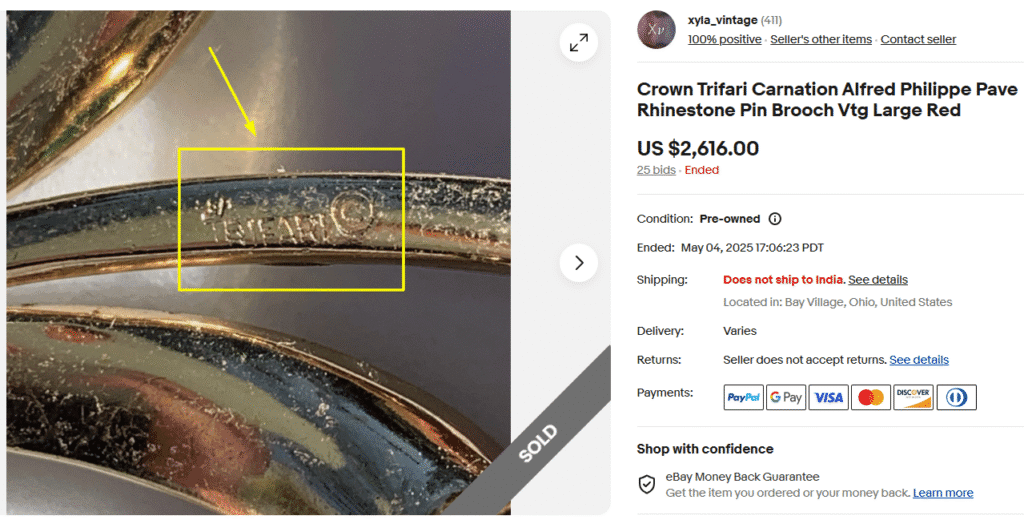
- Marks: Early pieces show “KTF” (1920s-30s). Then they switched to “Trifari” with a crown over the “T” (1930s-50s). After 1955, you’ll see “Trifari ©”. Some have “Trifari” in flowing script.
- What to look for: Their rhodium plating was top-notch, and they often used custom-cut rhinestones. The best pieces come from the “Crown Trifari” years when Alfred Philippe (who’d worked at Cartier!) was designing. Hunt for pieces with “invisible settings” – they’re worth more.
Miriam Haskell (1920s-present)
- Marks: The earliest pieces aren’t signed at all. Later, you’ll find “MIRIAM HASKELL” on an oval plaque, or sometimes block letters on a cartouche or horseshoe shape. Some early pieces just have an “H” on the clasp.
- What to look for: The craftsmanship is incredible – intricate wiring (usually gold-tone), hand-set stones, and lots of baroque pearls and filigree. Haskell pieces feel substantial in your hand. Even the unsigned early pieces fetch good money if you can spot her construction style.
Coro (1900s-1970s)
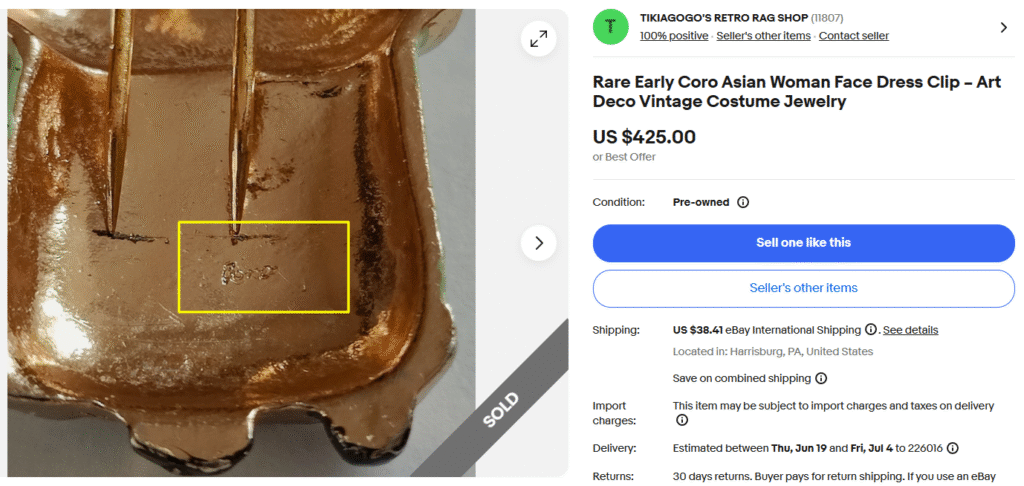
- Marks: They made tons of different lines. Look for “CORO” in various fonts, “Coro Craft” (their higher-end stuff), “Coro Duette” (clever brooches that split into dress clips), or “Vendome” (their luxury line after the 1940s).
- What to look for: They made everything from cheap to high-end. Their convertible pieces are clever, and they did beautiful work with colorful rhinestones and enamel.
Schreiner (1932-1970s)
- Marks: “SCHREINER,” “SCHREINER NEW YORK.” Weirdly, many of their best pieces aren’t marked at all or just had a paper tag (now long gone).
- What to look for: They did quirky things like setting rhinestones upside-down so the pointy part faces up (creates amazing sparkle), making big domed designs, and using “dog-tooth” prongs. You often have to identify them by their construction rather than marks.
Eisenberg (1930s-1990s)
- Marks: “Eisenberg Original” (earliest and most valuable), “Eisenberg Ice” (after 1940s), “Eisenberg ©.”
- What to look for: They started as a clothing company and made jewelry to dress up their outfits. Their rhinestones are exceptional – often unfoiled and set in sterling silver or rhodium-plated metal. The pieces are heavy and could pass for real diamond jewelry.
Boucher (Marcel Boucher, 1937-1970s)
- Marks: “MB” in a cartouche, “Marboux” (early pieces), “Boucher” (later work), “Boucher ©.” Often includes a design number.
- What to look for: His pieces are like sculptures – very three-dimensional with incredible detail. He did amazing animal designs and used high-quality plating. His work feels like fine jewelry.
Construction Clues
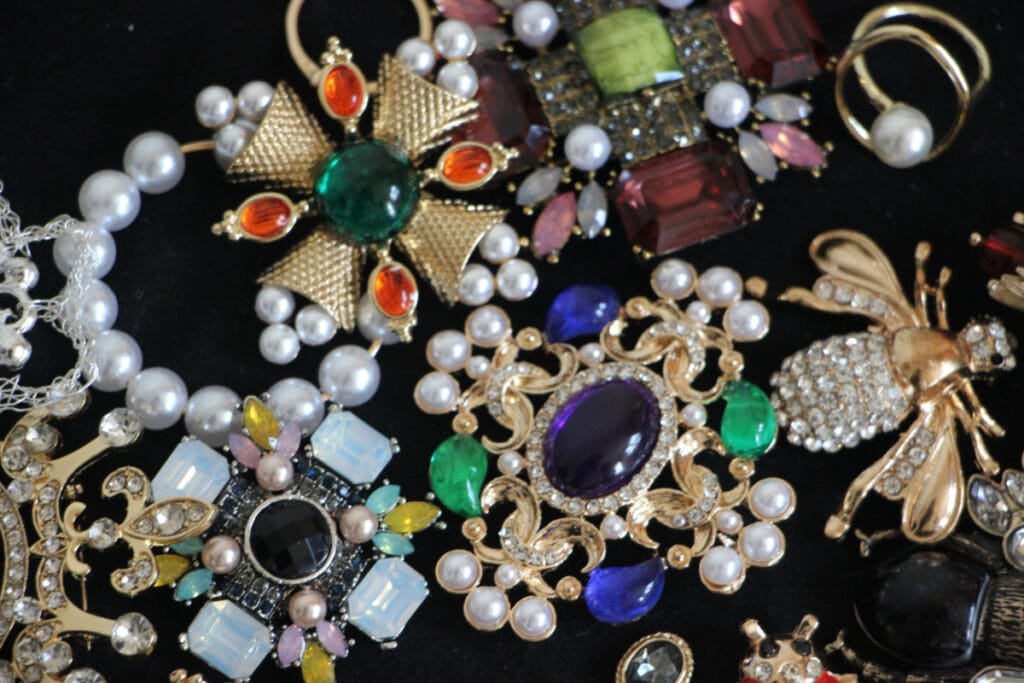
The way a jewelry piece was made can tell you a lot about its age and value. Here are some construction clues to look for:
Closures and Clasps:
- C-Clasps: Simple hooks without the safety catch on brooches – late 1800s to early 1900s.
- Trombone Clasps: Tube with sliding pin, mostly European – 1920s-40s.
- Roll-Over Safety Clasps: Pin tucks under rotating hood – standard for brooches from the 1930s on.
- Barrel Clasps: Screw-together halves on beaded pieces – pre-1970s.
- Fishhook Clasps: Basic hook-and-eye mechanism – older necklaces.
- Fold-Over Clasps: Hinged flap that snaps shut – vintage link bracelets.
- Spring Ring Clasps: Small circle with spring-loaded opening – mid-century onwards.
- Lobster Claw Clasps: Secure pinchy clasp – 1970s to present (not truly antique).
Earring Backs:
- Screw-backs were common from the 1920s to 50s
- Clip-backs became popular in the 1930s
- Clip-backs with comfort pads showed up in the 1940s
- Post earrings for pierced ears gained popularity from the 1960s onward
Settings:
- Prong Settings: Little metal “claws” grip the stones. Look for chunkier, heavier prongs on the older stuff.
- Pave Settings: Tiny stones set right next to each other to create a solid surface of sparkle.
- Bezel Settings: A metal rim wraps around the stone to hold it in place.
- Channel Settings: Stones sit snugly in a metal channel without any prongs showing.
- Gluing vs. Setting: Good vintage costume jewelry rarely has glued-in stones. If you spot glue (especially in older pieces), you’re probably looking at the cheaper stuff. Quality pieces have stones mechanically secured with prongs, bezels, or metal work.
What Makes Retro Costume Jewelry Valuable?

Now for the fun part – figuring out if that flea market find is worth $5 or $500! Here’s what drives value in vintage costume jewelry:
- Condition: condition makes or breaks value. A mint condition piece can be worth ten times more than the same piece with damage. Things you must always check: Are all stones present and secure? Is the finish intact (no worn plating)? Do clasps and mechanisms work properly? Is there any verdigris? Any chips, cracks, or repairs?
- Completeness: Complete sets are worth more, too – finding a matching necklace, bracelet, and earrings together (called a “parure”) is always more valuable than single pieces.
- Rarity and History: Just like any collectible, rarity drives the value of vintage costume jewelry, too. Limited production runs, experimental pieces, a designer’s prototype or sample, worn by a celebrity or featured in a film, and discontinued lines typically command higher prices.
- Brand Power: Let’s be real – brand names matter a ton in costume jewelry. The most valuable pieces come from renowned designers and quality manufacturers, such as Chanel, Schiaparelli, Miriam Haskell, Eisenberg, Trifari (especially Alfred Philippe designs), Marcel Boucher, and Joseff of Hollywood.
- Special Features: Certain decorative elements can make a piece extra desirable. Look for: Jelly Belly designs, Aurora Borealis finishes (rainbow iridescent coating), Art glass elements, three-dimensional designs, figurals (animals, people, or objects), and hand-painted enamel.
Note: This article is intended for informational, educational, and entertainment purposes only. Some images are illustrative and may not represent actual brands, products, or related entities. All trademarks, product names, brand logos, packaging, and other intellectual property referenced remain the exclusive property of their respective owners. Any brand mentions or references are provided solely for descriptive and educational context and do not imply any formal or commercial association.

